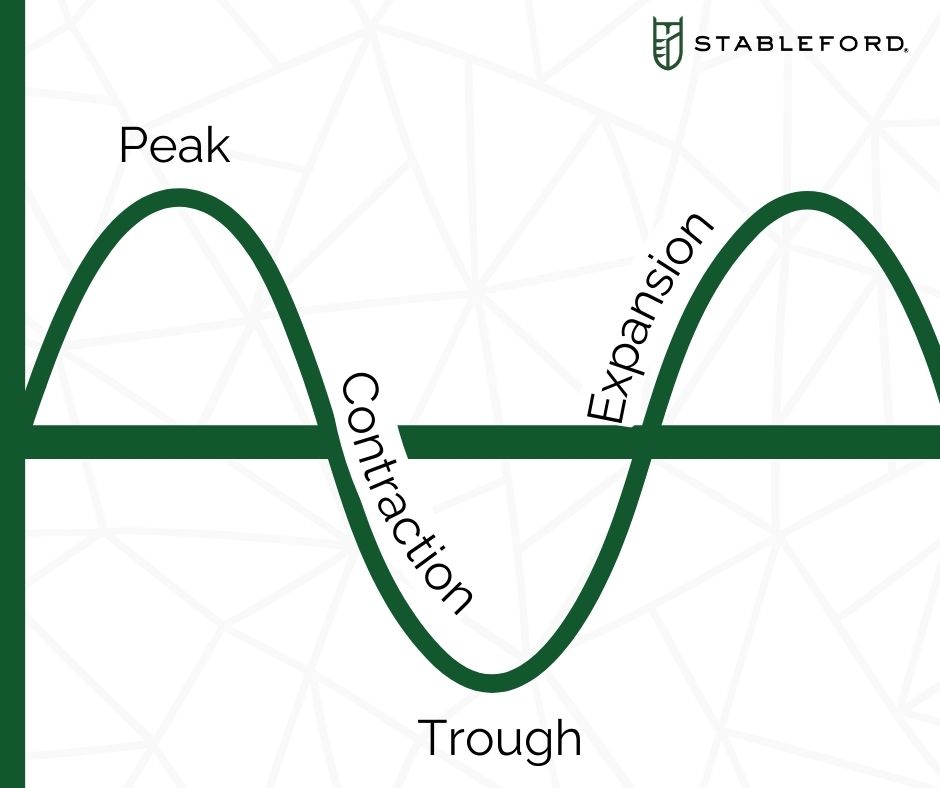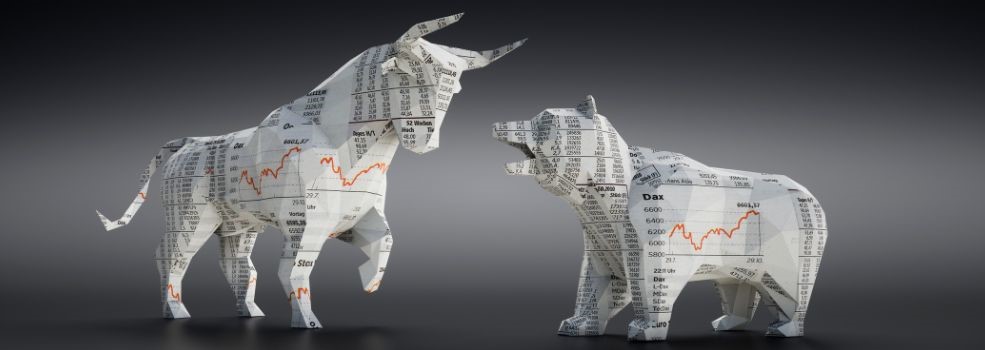Market cycles are patterns that occur repeatedly over time. They encompass a broad spectrum of types, such as Bear and Bull Markets, rallies, and sell-offs, as well as phases like expansions, peaks, contractions, and troughs.
Understanding the varied interpretations of market cycles, mastering the skill of identification, and observing historical trajectories equip investors with valuable insights for refining portfolio strategies. Knowledge of the characteristics of market or business cycles can help investors navigate their decisions and manage risk.

Understanding Market Cycles
At the core of sound investing lies an understanding of market cycles. Bull and Bear markets, the fundamental forces in finance, significantly shape investment strategies. These terms describe the overall direction of financial markets, specifically in terms of securities prices, such as stocks or bonds.
Bull and Bear markets are closely linked to the market cycle phases. Understanding business cycle phases provides nuanced insight to make informed investment decisions. These stages include:
Expansion
- Characteristics: In the expansion phase, economic activity is on the rise. Increased consumer spending, growing business investments, and a general sense of optimism exist. Stock markets often experience upward trends during this stage.
- Market Behaviors: Bull markets are common in the expansion phase. Stock prices tend to rise as businesses thrive, and investors are optimistic about future earnings.
- Investor Considerations: During the expansion phase, investors might consider a growth-oriented strategy. Focus on equities and sectors expected to benefit from increased economic activity. Diversification remains essential to mitigate risk.
Peak
- Characteristics: The peak represents the climax of economic growth. Key financial indicators, such as employment and production levels, reach their zenith. Inflation might start to rise, and interest rates may follow suit.
- Market Behavior: As the economy reaches its peak, stock markets may continue to perform well, but signs of potential overheating and overvaluation start to emerge. Investors become cautious, approaching a possible shift in the market cycle.
- Investor Considerations: As the economy reaches its peak, a more cautious approach is advisable. Consider rebalancing portfolios by trimming positions that may be susceptible to overvaluation.
Contraction
- Characteristics: The contraction phase, also known as a recession, is marked by a slowdown in economic activity. Unemployment rises, consumer spending decreases, and businesses cut back on investments. Central banks may respond by lowering interest rates to stimulate the economy.
- Market Behavior: Bear markets often prevail during contractions. Stock prices decline as economic uncertainties and negative sentiments dominate. Investors may experience losses, and risk aversion becomes more prominent.
- Investor Considerations: In this phase, a defensive strategy is prudent. Shift toward safer assets, such as bonds or defensive stocks.
Trough
- Characteristics: The trough represents the bottom of the economic cycle. Economic indicators hit their lowest points, and there is a sense of pessimism. However, it is also a phase where the groundwork for the next expansion begins.
- Market Behavior: Troughs often mark the end of Bear Markets. While stock prices may still be low, savvy investors see opportunities for potential growth as the economy gears up for a new expansionary phase.
- Investor Considerations: Troughs often present buying opportunities for long-term investors. Look for undervalued assets and consider gradually increasing exposure to equities.
Recognizing the signs of peak and trough points allows investors to adjust their portfolios strategically, aligning with the prevailing economic conditions. Successful investing involves adapting to the ever-changing market dynamics and positioning oneself for opportunities at each stage of the market cycle.
Risk Management Strategies

Effective risk management serves as the compass guiding investors through the unpredictable seas of the market. Diversification, a foundational principle of risk mitigation, involves spreading investments across different asset classes.
This shields against potential downturns and positions portfolios for growth in diverse market conditions.
In response to ever-changing market conditions, strategic Asset Allocation Adjustments based on market cycles become imperative. Tailoring portfolios to the prevailing environment ensures resilience in the face of fluctuations. Setting Stop-Loss Orders acts as a safety net, preventing significant losses when markets take an expected turn.
For investors with substantial assets, these strategies act as a robust defense, safeguarding their wealth from the storms of volatility.
Balancing Risks with Opportunities
The investment landscape is full of risks, but within those risks lie opportunities. Striking a balance between these elements is an art that defines successful investors.
Exploring Counter-Cyclical investments or embracing long-term investment strategies becomes essential in navigating market volatility.
Significant stock price declines typically coincide with market cycle downturns, such as contractions and recessions. Countercyclical investments thrive in adverse market conditions, providing a strategic hedge against turndowns.
Long-term strategies, resilient in the face of short-term fluctuations, align with the pursuit of enduring financial success. This delicate balance allows investors to navigate the shifting tides of the market confidently.
 Emotional Investing and Behavioral Biases
Emotional Investing and Behavioral Biases
Investing is not merely a financial endeavor; it’s a psychological exercise. Emotional decision-making and behavioral biases can cloud judgment, leading to suboptimal choices. Avoiding pitfalls like panic selling during downturns or succumbing to excessive optimism in Bull Markets is crucial for success.
An understanding that an upturn typically follows a downturn makes an investor less likely to miss out on the market’s best days and the associated gains in the subsequent phases of the business cycle.
Adapting to a Fast-Evolving Market
In the contemporary financial landscape, marked by technological advancements and global economic shifts, staying informed is not just an advantage but a necessity.
Staying up-to-date with market trends and economic indicators is a proactive approach to wealth management. Leveraging technology for real-time monitoring and management of investments is a strategic imperative. Whether it’s algorithmic trading or advanced analytics, embracing technology empowers investors to make timely and informed decisions in the fast-paced financial environment.
Navigating Financial Success: Strategic Insight into Market Cycles
Mastering the intricacies of investing requires a deep understanding of market cycles, diligent risk management, and the ability to seize opportunities in the ever-evolving world financial landscape. Integrating market cycles into a portfolio strategy, even when it simply means staying the course, can offer the opportunity for potential gains.
If you’re ready to optimize your financial strategy, now could be the ideal time. To explore personalized insights combined with an understanding of the current market landscape, call us at 480.493.2300 or contact us to schedule a complementary 15-minute consultation.


